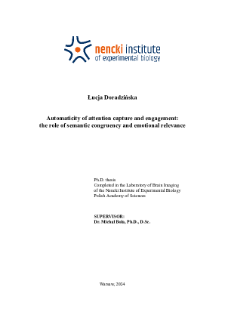
Object
Title: Automaticity of attention capture and engagement : the role of semantic congruency and emotional relevance : PhD thesis
Institutional creator:
Instytut Biologii Doświadczalnej im. Marcelego Nenckiego PAN
Contributor:
Bola, Michał (1986– ) : Supervisor
Publisher:
Nencki Institute of Experimental Biology PAS
Place of publishing:
Description:
[2], 53 pages, [7], offprints (various pagination) : illustrations ; 30 cm ; Summary of professional accomplishments: access to original works available only in the thesis' manuscript stored at the library collection ; Bibliography ; Summary in Polish
Degree name:
Degree discipline :
Degree grantor:
Nencki Institute of Experimental Biology PAS ; degree obtained in 2024
Type of object:
Abstract:
The amount of information we encounter in our perceptual environment exceeds the capacities of our cognitive system, and thus efficient navigation in everyday situations requires a selective mechanism that prioritizes behaviorally relevant contents. This is the assumed role of the selective attention mechanism. While attention has been extensively studied in simplified, artificial settings, the factors that might drive the deployment of attentional resources in naturalistic settings are not fully understood. In the present thesis, I present the outcomes of research conducted in order to delineate the scope of attentional prioritization of two recognized sources of perceptual saliency – namely semantic congruency and affective relevance. In the first study, we investigated whether objects that violate the semantic structure of the real-world scene automatically engage exogenous attention for longer than semantically congruent objects. The conducted experiment involved a central presentation of a scene and a peripheral presentation of a small target letter. We found that the presentation of semantically incongruent objects did not delay responses to the target identification task, which indicates that such objects did not benefit from automatic attentional engagement. At the same time presentation of disgust-evoking scenes was related to the robust attention-hold effect. The obtained results demonstrate that the affective relevance of the scene induces automatic engagement of exogenous attention, but semantic incongruency does cause a similar effect. In the second study, we tested whether an automatic attentional response to threats can be induced at the preconscious levels of visual processing. In the present experiment, we employed event-related potentials (ERP) to compare neural activity evoked by the subliminal and supraliminal perception of fearful and neutral facial expressions. The obtained pattern of results suggests that consciously perceived fearful faces were preferentially encoded and automatically prioritized by bottom-up attention. Importantly, when perceived outside awareness fearful faces were still preferentially encoded, but we found no evidence for attentional prioritization. Therefore, our findings show that attentional prioritization of threats depends on perceptual consciousness. In the third study, we reanalyzed data collected in the second study in order to investigate the influence of attention on neural correlates of visual awareness. It has been proposed that an early ERP component called Visual Awareness Negativity (VAN) constitutes a neural marker of subjective conscious experience that is independent of attentional selection. Therefore, in the conducted analysis we investigated whether VAN is indeed not affected by exogenous attention associated with the inherent saliency of presented stimuli and endogenous attention induced by task relevance. Our findings revealed that VAN was highly dependent on attentional manipulations in both early (140–200 ms) and late time windows (200–350 ms). Thus, the obtained results challenge the view that VAN constitutes a specific, attention-independent mechanism of subjective conscious experience. Overall, the presented work contributes to a better understanding of how attention operates in naturalistic settings by elucidating the limitations of exogenous attention capture and engagement. Our findings indicate that the perception of real-world images involves the integration of bottom-up and top-down mechanisms that mutually shape the behavioral and neural response. Further, our results reveal the role of conscious evaluation and significantly add to the discussion about the relationship between awareness and attention.
Detailed Resource Type:
Resource Identifier:
Source:
Language:
Language of abstract:
Terms of use:
Copyright-protected material. May be used within the limits of statutory user freedoms
Copyright holder:
Publication made available with the written permission of the author
Digitizing institution:
Nencki Institute of Experimental Biology of the Polish Academy of Sciences
Original in:
Library of the Nencki Institute of Experimental Biology PAS
Access:
Object collections:
- Nencki Institute of Experimental Biology PAS
- Nencki Institute of Experimental Biology PAS > Dissertations
- Nencki Institute of Experimental Biology PAS > Dissertations > PhD Thesis
Last modified:
Jun 24, 2024
In our library since:
Jun 21, 2024
Number of object content downloads / hits:
3
All available object's versions:
https://rcin.org.pl/ibd/publication/277832

 INSTYTUT ARCHEOLOGII I ETNOLOGII POLSKIEJ AKADEMII NAUK
INSTYTUT ARCHEOLOGII I ETNOLOGII POLSKIEJ AKADEMII NAUK
 INSTYTUT BADAŃ LITERACKICH POLSKIEJ AKADEMII NAUK
INSTYTUT BADAŃ LITERACKICH POLSKIEJ AKADEMII NAUK
 INSTYTUT BADAWCZY LEŚNICTWA
INSTYTUT BADAWCZY LEŚNICTWA
 INSTYTUT BIOLOGII DOŚWIADCZALNEJ IM. MARCELEGO NENCKIEGO POLSKIEJ AKADEMII NAUK
INSTYTUT BIOLOGII DOŚWIADCZALNEJ IM. MARCELEGO NENCKIEGO POLSKIEJ AKADEMII NAUK
 INSTYTUT BIOLOGII SSAKÓW POLSKIEJ AKADEMII NAUK
INSTYTUT BIOLOGII SSAKÓW POLSKIEJ AKADEMII NAUK
 INSTYTUT CHEMII FIZYCZNEJ PAN
INSTYTUT CHEMII FIZYCZNEJ PAN
 INSTYTUT CHEMII ORGANICZNEJ PAN
INSTYTUT CHEMII ORGANICZNEJ PAN
 INSTYTUT FILOZOFII I SOCJOLOGII PAN
INSTYTUT FILOZOFII I SOCJOLOGII PAN
 INSTYTUT GEOGRAFII I PRZESTRZENNEGO ZAGOSPODAROWANIA PAN
INSTYTUT GEOGRAFII I PRZESTRZENNEGO ZAGOSPODAROWANIA PAN
 INSTYTUT HISTORII im. TADEUSZA MANTEUFFLA POLSKIEJ AKADEMII NAUK
INSTYTUT HISTORII im. TADEUSZA MANTEUFFLA POLSKIEJ AKADEMII NAUK
 INSTYTUT JĘZYKA POLSKIEGO POLSKIEJ AKADEMII NAUK
INSTYTUT JĘZYKA POLSKIEGO POLSKIEJ AKADEMII NAUK
 INSTYTUT MATEMATYCZNY PAN
INSTYTUT MATEMATYCZNY PAN
 INSTYTUT MEDYCYNY DOŚWIADCZALNEJ I KLINICZNEJ IM.MIROSŁAWA MOSSAKOWSKIEGO POLSKIEJ AKADEMII NAUK
INSTYTUT MEDYCYNY DOŚWIADCZALNEJ I KLINICZNEJ IM.MIROSŁAWA MOSSAKOWSKIEGO POLSKIEJ AKADEMII NAUK
 INSTYTUT PODSTAWOWYCH PROBLEMÓW TECHNIKI PAN
INSTYTUT PODSTAWOWYCH PROBLEMÓW TECHNIKI PAN
 INSTYTUT SLAWISTYKI PAN
INSTYTUT SLAWISTYKI PAN
 SIEĆ BADAWCZA ŁUKASIEWICZ - INSTYTUT TECHNOLOGII MATERIAŁÓW ELEKTRONICZNYCH
SIEĆ BADAWCZA ŁUKASIEWICZ - INSTYTUT TECHNOLOGII MATERIAŁÓW ELEKTRONICZNYCH
 MUZEUM I INSTYTUT ZOOLOGII POLSKIEJ AKADEMII NAUK
MUZEUM I INSTYTUT ZOOLOGII POLSKIEJ AKADEMII NAUK
 INSTYTUT BADAŃ SYSTEMOWYCH PAN
INSTYTUT BADAŃ SYSTEMOWYCH PAN
 INSTYTUT BOTANIKI IM. WŁADYSŁAWA SZAFERA POLSKIEJ AKADEMII NAUK
INSTYTUT BOTANIKI IM. WŁADYSŁAWA SZAFERA POLSKIEJ AKADEMII NAUK
































